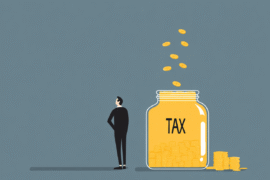This article may contain references to products or services from one or more of our advertisers or partners. We may receive compensation when you click on links to those products or services. Nonetheless, our opinions are our own.
The information presented in this article is accurate to the best of our knowledge at the time of publication. However, information is subject to change, and no guarantees are made about the continued accuracy or completeness of this content after its publication date.
When you see a tax lien on your credit report, it can feel like a heavy weight dragging down your financial standing. You’re not alone; many people have found themselves in similar situations, often facing challenges that seem insurmountable. But the good news is that you don’t have to live with a tax lien indefinitely. Understanding the steps to get it removed can empower you to reclaim your credit health and move forward with confidence. You’ll discover practical strategies to navigate the process of removing a tax lien from your credit report, along with insights that can help you avoid future pitfalls. Let’s explore how you can take control of your financial narrative and pave the way for a brighter credit future.
- Understanding Tax Liens and Their Impact on Your Credit Report
- Recognizing the Steps to Take for Removal
- Gathering Documentation to Support Your Case
- Negotiating with the IRS for a Tax Lien Release
- Working with Credit Bureaus to Update Your Report
- Preventing Future Tax Liens and Protecting Your Credit Health
- Frequently Asked Questions
- What is a tax lien, and how does it affect my credit report?
- How can I check if a tax lien is on my credit report?
- How can I remove a tax lien from my credit report?
- What if I can’t afford to pay off the tax lien right away?
- Can I dispute a tax lien if I believe it’s inaccurate?
- How long does a tax lien stay on my credit report?
- Will having a tax lien removed improve my credit score?
- Can a lawyer help remove a tax lien?
- Recommended Reads
Understanding Tax Liens and Their Impact on Your Credit Report
Tax liens can be daunting on your credit report, often leading to financial frustration and confusion. When the IRS places a lien against your property due to unpaid taxes, it serves as a public claim against your assets, which can significantly impact your credit score. Understanding the nuances of this process is crucial for anyone who finds themselves in this predicament. It’s essential to know that a tax lien can stay on your credit report for up to seven years, affecting your ability to secure loans or credit during that time.
Here are some key points to consider regarding tax liens and their effects:
Credit Score Impact: A tax lien can lower your credit score by a notable amount, making it harder for you to qualify for favorable interest rates.
Loan Approval Challenges: Lenders may view a tax lien as a red flag, perhaps leading to loan denials or unfavorable terms.
Future Borrowing Effects: Even after it’s paid off, the lien can still hinder your financial opportunities if it’s not removed from your credit report.
Moreover, keeping accurate records of your tax payments and communicating effectively with the IRS can aid in the resolution process. If you take swift action, address any tax debts, and understand your rights, you can begin removing that lien and improving your credit standing.
Recognizing the Steps to Take for Removal
Removing a tax lien from your credit report is a significant step toward regaining control of your financial health. To start this process, you must gather all relevant documentation related to the tax lien, including any notices or correspondence you’ve received from the IRS or your state tax agency. It’s essential to know whether the lien has been paid off or if you need to settle any outstanding tax debt. If you haven’t already done so, consider contacting a tax professional who can provide personalized advice based on your situation.
Review your credit report: Check for any inaccuracies that could hinder the removal process.
Request a lien withdrawal: If you’ve paid off the tax lien or settled the debt, submit a request for withdrawal to the appropriate government agency.
File a dispute: If the lien is incorrect or outdated on your credit report, file a dispute with the credit bureaus, providing supporting documents.
Monitor your credit: After taking these steps, stay vigilant about your credit report to ensure the lien is updated or removed successfully.
Quick reference table to keep track of your actions:
| Action | Status | Notes |
|---|---|---|
| Gather documentation | Pending | Collect all records related to the lien. |
| Request lien withdrawal | Pending | Submit the necessary forms to the tax authority. |
| File a dispute | Pending | Contact credit bureaus if discrepancies arise. |
| Monitor credit report | Ongoing | Check regularly for updates on your credit status. |
Gathering Documentation to Support Your Case
To strengthen your case for removing a tax lien from your credit report, gathering all relevant documentation substantiating your claim is crucial. Start by compiling official records related to the lien, such as:
Payment receipts showing the lien has been satisfied
Correspondence with tax authorities proving any disputes or errors
Documentation of any agreements or settlements made
Your credit report, highlighting the entry of the tax lien
Having these documents at your fingertips will provide clarity and help you present a solid argument to credit bureaus or potential creditors. Additionally, consider organizing your evidence clearly and concisely. A simple table can help illustrate your situation more effectively:
| Document Type | Date | Details |
|---|---|---|
| Payment Receipt | MM/DD/YYYY | Full payment of the tax amount |
| Correspondence | MM/DD/YYYY | Dispute letter to the tax authority |
| Settlement Agreement | MM/DD/YYYY | Agreement terms met |
As you gather this paperwork, review it carefully to ensure that everything is accurate and up to date. This diligence will help clarify your position and set the stage for a more effective resolution process.
Voted "Best Overall Budgeting App" by Forbes and WSJ
Monarch Money helps you budget, track spending, set goals, and plan your financial future—all in one app.
Get 50% OFF your first year with code MONARCHVIP
Negotiating with the IRS for a Tax Lien Release
Negotiating with the IRS for a tax lien release can feel daunting, but understanding the process is key to regaining financial freedom. Gather all pertinent documentation about your tax lien and your current financial situation. This includes income statements, expenses, and any hardship information that can support your case. Once you have everything in order, consider the following approaches:
Request a Lien Release: If you’ve paid off the taxes owed, you can formally request a lien release. Ensure you have proof of payment to present.
Negotiate an Installment Agreement: If you can’t pay the full amount, propose a payment plan to the IRS. Having an agreement might motivate them to release the lien sooner.
Offer in Compromise: If your financial circumstances allow, you could negotiate a reduced amount to settle your tax debt. Accepting this offer often comes with a lien release.
It’s also beneficial to communicate with the IRS patiently and professionally. A well-documented proposal and a clear statement of your financial situation can make a significant difference in the outcome. If you feel overwhelmed, consider seeking the help of a tax professional experienced in negotiating with the IRS. Remember, every case is unique, so stay persistent and take steps toward resolving your tax lien and restoring your credit standing.
Working with Credit Bureaus to Update Your Report
To effectively work with credit bureaus and update your report, you’ll want to start by gathering all necessary documentation for your tax lien. This might include court documents, payment records, or letters from the tax authority confirming the lien has been resolved. Once you have your paperwork in order, you can draft a dispute letter to send to the relevant credit reporting agencies. Be sure to include:
Your personal information: Full name, address, and social security number.
Account details: The specific account associated with the lien, including any account numbers.
Explanation: A clear and concise reason for your dispute, citing the removal of the lien.
When sending your dispute, it’s also helpful to utilize certified mail so you have a record of your dialogue. Credit bureaus typically have 30 days to investigate your claim, and during this time, they will reach out to the relevant parties to verify the accuracy of the information. Keep an eye on your mail for their response, and if the lien is removed, don’t forget to check that your credit report is updated. If they uphold the lien, you can request any additional information contributing to their decision.
Preventing Future Tax Liens and Protecting Your Credit Health
Taking proactive steps can significantly reduce your chances of encountering tax liens in the future while safeguarding your credit health. Here are a few vital strategies to consider:
Stay Informed: Stay updated on tax laws and deadlines. Being aware of your tax obligations can help you plan accordingly.
File Your Taxes on Time: Make it a habit to file your tax returns promptly, even if you can’t pay the full amount. This shows the IRS that you’re making an effort.
Set Up a Payment Plan: If you anticipate difficulty paying your taxes, explore available payment options with the IRS to avoid liens altogether.
Monitor Your Credit Report: Regularly check your credit report for any inaccuracies. Dispute any discrepancies promptly to protect your score.
If you ever find yourself on shaky ground with the IRS, consider contacting a tax professional. Their expertise can guide you through challenging situations, ensuring you stay compliant and lessen the risk of future tax-related issues. Additionally, be cautious with credit inquiries and avoid excessive borrowing that could strain your financial standing further.
Comparison of timely vs. missed tax payments:
| Action | Impact on Credit |
|---|---|
| Timely Payments | Positive impact, strengthens credit score |
| Missed Payments | Adverse impact, risk of tax lien |
Frequently Asked Questions
What is a tax lien, and how does it affect my credit report?
A tax lien is a legal claim made by a government entity against your assets when you fail to pay tax debts. A tax lien on your credit report can significantly lower your credit score, making it harder to secure loans, credit cards, or favorable interest rates.
How can I check if a tax lien is on my credit report?
You can check your credit report for free once a year at AnnualCreditReport.com. Make sure to look specifically for any tax liens or other negative marks. If you find one, it’s important to confirm the details are accurate.
How can I remove a tax lien from my credit report?
To remove a tax lien, start by paying the owed taxes. Once you’ve settled the debt, request a Certificate of Release from the IRS, which proves the lien has been satisfied. After obtaining this certificate, you can ask the credit bureaus to update your credit report.
What if I can’t afford to pay off the tax lien right away?
If paying off the lien immediately is impossible, consider negotiating with the IRS for a payment plan or an Offer in Compromise, allowing you to settle for less than what you owe. Once settled, you can proceed with the steps to remove the lien from your credit report.
Can I dispute a tax lien if I believe it’s inaccurate?
If you think the lien is incorrect, you can dispute it with the credit bureaus. Gather supporting documents to prove your case. They must investigate your claim and update your credit report if it is inaccurate.
How long does a tax lien stay on my credit report?
A tax lien can stay on your credit report for up to seven years from the filing date. However, if you pay the lien and receive a release, it should be removed more quickly if you proactively request this from the credit bureaus.
Will having a tax lien removed improve my credit score?
Yes, removing a tax lien can improve your credit score. Once the lien is gone, you may find it easier to obtain credit and secure lower interest rates, positively impacting your financial opportunities.
Can a lawyer help remove a tax lien?
Hiring a tax attorney or a credit repair professional can be beneficial, especially if you’re dealing with complex tax issues or want to ensure that removing the lien is handled correctly. They can provide advice and assistance tailored to your situation.

Reviewed and edited by Albert Fang.
See a typo or want to suggest an edit/revision to the content? Use the contact us form to provide feedback.
At FangWallet, we value editorial integrity and open collaboration in curating quality content for readers to enjoy. Much appreciated for the assist.
Did you like our article and find it insightful? We encourage sharing the article link with family and friends to benefit as well - better yet, sharing on social media. Thank you for the support! 🍉
Article Title: Tax Lien Removal Guide: Fix Your Credit the Right Way
https://fangwallet.com/2025/05/03/tax-lien-removal/The FangWallet Promise
FangWallet is an editorially independent resource - founded on breaking down challenging financial concepts for anyone to understand since 2014. While we adhere to editorial integrity, note that this post may contain references to products from our partners.
The FangWallet promise is always to have your best interest in mind and be transparent and honest about the financial picture.
Become an Insider

Subscribe to get a free daily budget planner printable to help get your money on track!
Make passive money the right way. No spam.
Editorial Disclaimer: The editorial content on this page is not provided by any of the companies mentioned. The opinions expressed here are the author's alone.
The content of this website is for informational purposes only and does not represent investment advice, or an offer or solicitation to buy or sell any security, investment, or product. Investors are encouraged to do their own due diligence, and, if necessary, consult professional advising before making any investment decisions. Investing involves a high degree of risk, and financial losses may occur including the potential loss of principal.
Source Citation References:
+ Inspo
There are no additional citations or references to note for this article at this time.












































